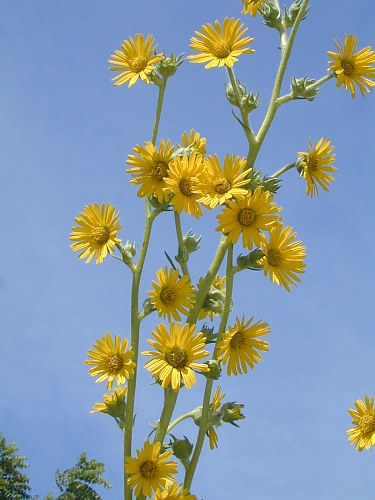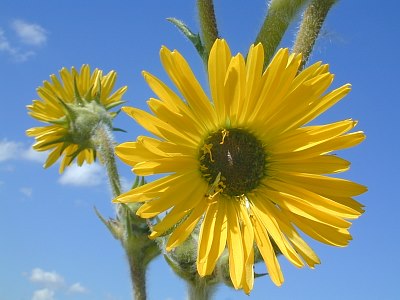Description: A mature specimen of this perennial plant ranges from 6-12' tall. The central stem is thick, light to medium green, and has conspicuous white hairs. There is some branching into flowering stems in the upper part of the plant. The basal leaves are 12-24" long and about half as wide. They are covered in fine white hairs, broadly lanceolate in overall shape, but deeply lobed or pinnatifid. The leaves become much smaller as they ascend up the stem.

The inflorescence
is very tall and elongated, with yellow composite flowers about 3-4"
across. They resemble wild sunflowers in overall size, shape, and
structure. However, like other Silphium spp., the
small tubular disk florets are sterile, while the ray florets are
fertile. There is little floral scent. A mature Compass Plant has 6-30
of these composite flowers, which bloom during mid-summer for about 1½
months. The seeds are large-sized, but flat and light, and can be
carried several feet by the wind. A large central taproot can extend 15
ft. into the ground. A resinous substance is produced by the upper stem
when the plant is blooming. This plant can live up to 100 years.
Cultivation:
The preference is full sun and moist to slightly dry conditions. A deep
loamy soil is preferred for the central taproot. It takes several years
for a seedling to develop into a full-sized mature plant. Mature plants
are easy to maintain, resist drought, and can handle competition from
other plants. If planted on a slope, there is a tendency to flop over,
particularly while blooming.
Range & Habitat:
This is a typical plant of black soil prairies in the tallgrass region.
It often co-occurs with Andropogon gerardii (Big
Bluestem). Other habitats include sand prairies, savannas, glades, and
areas along railroads. Compass Plant is fairly common throughout most
of Illinois, except in the SE and scattered western counties, where it
is uncommon or absent (see Distribution
Map). This plant recovers from occasional fires readily.
Compass Plant is native to Illinois.

Faunal Associations:
Long-tongued bees are the primary pollinators of the flowers, including
bumblebees, Miner bees, large Leaf-Cutting bees, and others.
Short-tongued Halictine bees and Syrphid flies also visit the flowers,
but they are less effective at pollination. Occasionally, Sulfur
butterflies and Monarchs may visit the flowers for nectar. Several
species of insects are specialist feeders of Compass Plant. This
includes the uncommon Okanagana balli (Prairie
Cicada), whose grubs feed on the large taproot, while a Rynchites
sp. (Silphium Beetle) and its larvae feed on the flower heads
and stems. The larvae of Antistrophus rufus and Antistrophus
minor (Gall Wasp spp.) feed within the stems, forming galls
that are not visible from the outside. Nonetheless, they attract the
hyperparasitic wasp Eurytoma lutea, whose larvae
feed on these gall formers. Similarly, the larvae of Mordellistena
aethiops (Tumbling Flower Beetle sp.) feed within the stems,
while the adults may eat the flowers. The oligolectic aphid Iowana
frisoni sucks the juices from the flowering stems.
Photographic Location:
The photographs of the flowering stalks and flowerheads were taken at
the Lincoln Book Bindery in Urbana, Illinois, while the photograph of
the lower leaves was taken at Meadowbrook Park in Urbana, Illinois.

Comments: The common name derives from the belief by pioneers that the leaves of Compass Plant pointed in a north-south direction. While this is probably true more often than not, it is not always reliable. The resin was used by Indian children as a chewing gum. With its imposing heighth, interesting leaves, and abundant yellow flowers, Compass Plant is an extraordinary plant. No tallgrass prairie is complete without a sizeable population of them.